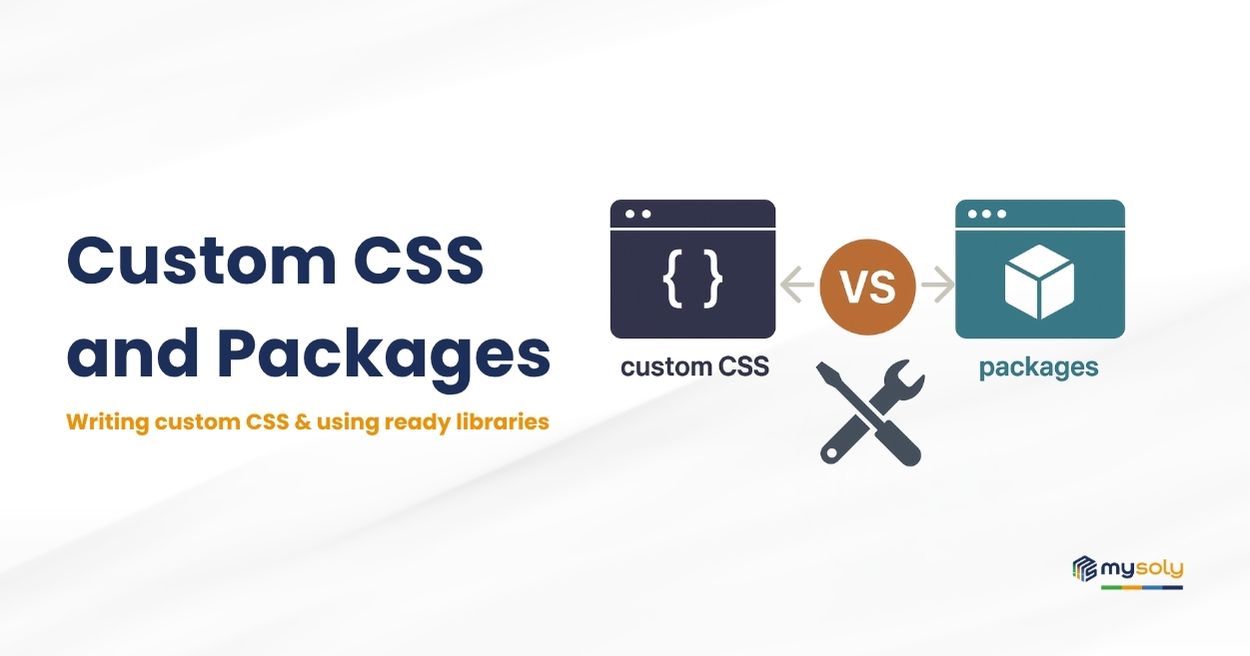Choosing between custom CSS and packages in Frontend Development
1. Introduction
Related to custom CSS and packages in Frontend Development, developers often face an important decision. Should they write their own CSS or use a ready package? This choice affects performance, maintenance, user experience, and overall code quality. Sometimes writing a few custom lines is best. However, using one smart package can finish a long task in minutes.
This article explains the difference between writing custom CSS and using ready libraries. It also shows when each option is more effective with real examples.
2. Understanding Custom CSS and Packages
Custom CSS means code written directly by the developer. It includes styles using @keyframes, transform, or transition. Developers know exactly how the browser handles every rule. The main advantage is full control, while the main disadvantage is manual effort.
Packages, however, are pre-built component libraries used mainly in React projects. Examples include typewriter-effect, react-modal, framer-motion, and react-toastify.
These tools save time and reduce repetitive work. But sometimes they increase bundle size and reduce flexibility.
Therefore, the decision between custom CSS and packages in Frontend Development affects performance, sustainability, and responsiveness. It is not just a visual choice but an architectural one.
Example: The Typewriter effect
For small animations, using a custom hook or CSS is often more efficient.
For example, the typewriter-effect package updates innerHTML for every character. This skips React’s virtual DOM diffing and may slow small devices.
A custom hook can create the same result with much less CPU usage—about 0.6 ms vs 3.8 ms.
Method | CPU Load | SSR Support | Control | Advice |
Custom Hook | 1 % | Full | Full control | Safest |
react-simple-typewriter | 2 % | Yes | Medium | Fast solution |
typewriter-effect DOM update | 5 %+ | Window error | Limited | Not recommended |
Browser Compatibility and Performance
Browser | Custom Hook | react-simple-typewriter | typewriter-effect |
Chrome / Edge / Firefox | Works smoothly | Works smoothly | Works smoothly |
Android Chrome | Works perfectly | Works perfectly | Works perfectly |
Safari | Works well, but sometimes small letter jumps appear | Sometimes shows letter jumps | Sometimes shows letter jumps |
iOS Safari | Works well | Animations may slow down intentionally | Animations may slow down intentionally |
SSR Compatibility
- typewriter-effect: It depends on the Window object and causes errors in SSR environments.
- react-simple-typewriter: It works with SSR but offers limited state control.
- Custom Hook: It is 100% SSR-compatible and runs safely with Vite or Next.js.
3. Decision Factors, Use Cases & Comparison
In custom CSS and packages in Frontend Development, the decision depends on performance, maintenance, user experience, and team structure. Both options have advantages and disadvantages. Evaluating them carefully creates better long-term results.
Criterion / Case
Custom CSS
Packages
Bundle Size
Low
High
Performance
High
Medium
Customization
Full control
Limited
Development Speed
Slower
Faster
Maintenance
Manual work
Documentation support
Responsive Adaptability
Flexible
Depends on package
Learning Curve
Steeper
Easier
Render Time
Faster
Slower
CPU Load
Low
Medium–High
Project Scale
Good for small–medium projects
Ideal for large–complex projects
Maintenance Ease
Full control, more effort
Easier updates, external dependency
UX & Responsive Design
Full control, unique UX
Predefined UX, overrides needed
Team Type
Experienced teams
Junior or prototype teams
Example Use
Landing page, typewriter, custom animation
Dashboard, SaaS, modals, tooltips
Result
Gives control but takes time
Offers speed but limits freedom
Key factors when choosing between Custom CSS and Packages
- a) Project Scale
Small or single-page projects don’t need extra dependencies. Therefore, custom CSS is better for landing or portfolio sites.
However, medium or large SaaS or dashboard projects benefit from ready packages that reduce code repetition and simplify maintenance. - b) Performance
When every animation frame matters, custom CSS is lighter and more predictable.
On the other hand, packages often bring unnecessary code that slows rendering. - c) Maintenance
Custom CSS gives total control but requires more manual updates.
Packages, however, receive regular updates and bug fixes from the community. On the other hand, it leads to external dependency. - d) UX and Responsive Design
Custom CSS allows unique design and full creative freedom.
On the other hand, packages follow predefined responsive behaviors, so overrides may be necessary. - e) Code Readability and Team Experience
Experienced teams prefer custom CSS for better readability and structure.
However, new or fast-prototyping teams prefer well-documented packages for quick results.
Situation
Recommended Choice
Explanation
Simple landing page or one small effect
Custom CSS
Lightest and fastest solution
Large dashboard or SaaS platform
Package
Speeds up development and simplifies maintenance
Typewriter effect in small area
Custom Hook / CSS
Avoids high CPU load from packages
Modal or Tooltip components
Package
Offers ready accessibility and focus management
- a) Project Scale
4. Conclusion
The Typewriter example shows the real balance clearly. A small animation may look simple but affect performance greatly. Using custom CSS instead of a heavy library saves both speed and resources.
Frontend work is the art of finding balance. Custom CSS gives full control and flexibility. However, packages save time and reduce repetition. The best choice depends on project size, team experience, and technical goals.
In summary:
- Small animations → Custom CSS
- Complex components → Packages
- Performance-focused apps → Avoid extra dependencies
“Writing one extra line today can prevent hundreds of issues tomorrow.”
“An effect should look good and perform efficiently.”



